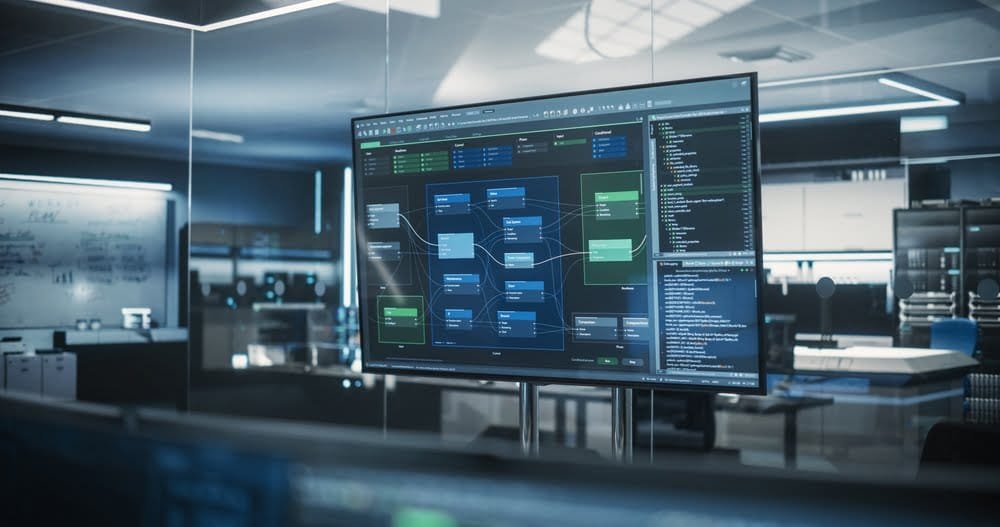New technology has always transformed aspects of our lives, but perhaps none has more potential to bring change than artificial intelligence (AI) and machine learning (ML). While the latest developments are watched with excitement by some and trepidation by others, engineers must look at how best to use them.
Among the areas where these developments will have the most impact is software, and already, we are seeing how software engineers are using these exciting new technologies. One GitHub survey found 92% of software developers use AI to some degree. We would like to explore some of the reasons.
We mentioned that a growing number of software developers are using AI to create low-code frameworks to develop their applications. There are other benefits as well.
The difference between AI and ML
The terms AI and ML are often used interchangeably, but although they are similar, they are not the same. AI is a broader term referencing the ability of computers to use logic to perform tasks in the real world. ML is one approach to AI that uses algorithms, data analysis, equations, and modeling to allow computers to identify patterns. Both have a wide range of applications across a wide variety of sectors, from the home to education to healthcare, as well as in business and manufacturing.
Natural language processing
Natural language processing allows the ability of computer applications to understand both text and spoken word. This is already forming technology that is part of our daily lives, such as text-to-speech dictation applications, chatbots, and voice-operated GPS systems.
When using natural language processing in applications, software engineers must break down the parts of speech so that the computer can make sense of it. Issues that might be faced can include words with more than one, meaning where the computer will need to work out which meaning is being used, named entity recognition such as personal and place names, and coreference resolution, where the computer has to understand that two words may refer to a single entity such as “he” and “Fred” when referring to a particular person.
For effective integration and utilization of NLP features, detailed API documentation is essential. This documentation should include clear instructions on endpoints, request and response formats, and examples to help developers implement NLP functionalities in their applications seamlessly.
Predictive analytics
Predictive analytics predicts future trends using internal and external data combined with statistical algorithms. This has a myriad of uses in business, such as improving delivery times, organizing inventory, and increasing sales. Traditionally carried out by human analysts, AI has the power to make these tasks more efficient. Machine learning and historical data can be used with known data but does not help when historical data does not predict the future, such as changing weather patterns or a natural disaster affecting the shipping of raw materials. AI increases the ability to flag up possible and likely events before they happen, allowing businesses time to prepare.
This needs to be paired with monitoring technology such as the Internet of Things (IoT), a technology that combines the things we use with the Internet to create networks of connected devices, resulting in smart homes, hospitals, and even cities. In a warehouse, for example, an IoT system can monitor in real-time, sending an alert of low stock and allowing more to be ordered. Over time, an AI-based system will start to recognize patterns from the data gathered, allowing stock to be ordered and stored more effectively.
Businesses are requiring increasing numbers of skilled engineers with a good understanding of AI and machine learning technology, including the IoT, making it a smart career choice with training options such as Master’s degrees widely available either in person or via high-quality online courses. A good example of these can be found at Baylor University. For those wondering what is the IoT and other AI-powered applications are, these are aspects of the Master’s programs at Baylor University that are designed for aspiring software engineers who wish to study for an accredited Master of Science in Computer Science online degree. For example, students can study modules that focus on software verification and validation and data communications, two important aspects of navigating the IoT as a highly skilled software engineer.
Recommendation systems
Success in business often rides on getting the right products in front of the right customers. Particularly in e-commerce, this means understanding what a particular customer is likely to want to buy so these can appear in their recommendations or targeted advertisements. As well as e-commerce, this can be used in media and entertainment systems or social media to analyze viewing patterns to find content that will interest them. AI can be used to analyze patterns in a customer or population of customers to make increasingly accurate predictions and increase engagement. It also has implications for healthcare, where it can use trends in medical history to recommend what is likely to be the most effective treatment, helping to reduce the overall cost.
Security software
In security software, machine learning systems can analyze the regular traffic patterns in a company network. It can also monitor connections, logins, dataflow, and access to check for unusual and, therefore, possibly suspicious activity. If something suspicious is noted, it can alter IT systems so that prompt action can be taken to secure the network and any sensitive data.
Test architecture is likely to become increasingly important, with new software being continually tested to check for any glitches, bugs, or possible security concerns. Automating these tests will allow them to be carried out more regularly and efficiently. A lot of DevOps tools and Agile processes can help improve security.
Is this the end for the human software developer?
One of the great fears about AI is that it might render human operatives obsolete. However, this is unlikely to be the case; current AI technology is nowhere near being able to replace human software developers. However, AI is transforming the role. By automating tasks, it can free up the software developer for other, more creative tasks, while the continual gathering and analysis of data will alert the software developer to potential problems before they cause significant trouble. Also, around 80% of programmers report that AI will make their code more collaborative. Instead of replacing human software developers and engineers, AI will fuel demand for well-qualified software engineers who fully understand AI technology and understand how to use it at every stage of software design, from initial concepts to the development, testing, and implementation as well as the monitoring of software to ensure that it is running securely and efficiently.
For anyone considering a career in IT or wanting to advance an existing career, gaining qualifications through courses that cover AI, machine learning, the Internet of things, and any other AI-powered technology is a step well worth taking. AI-powered systems are only going to increase over the next years and decades, ensuring that software developers and engineers remain very much in demand.



yes